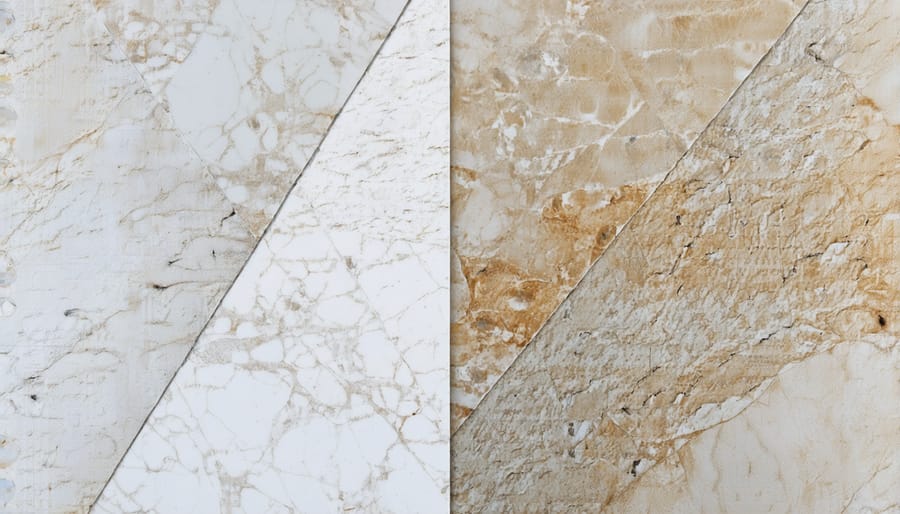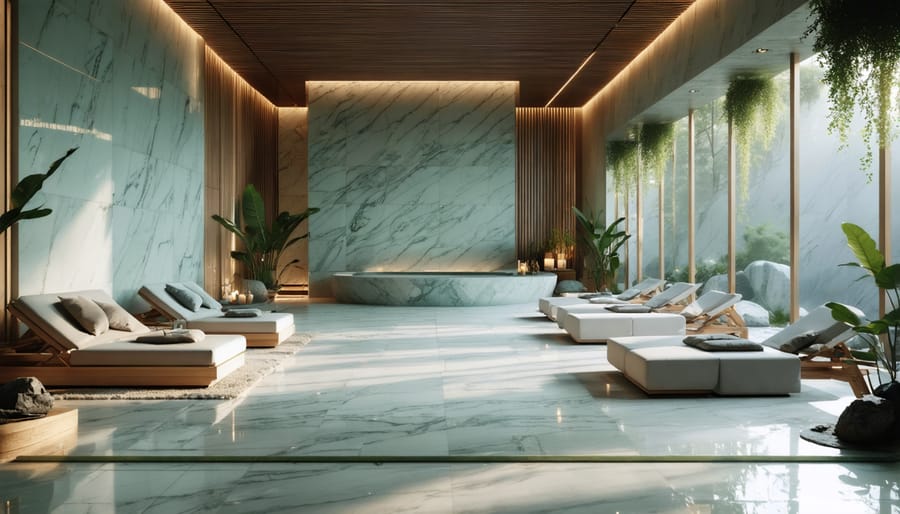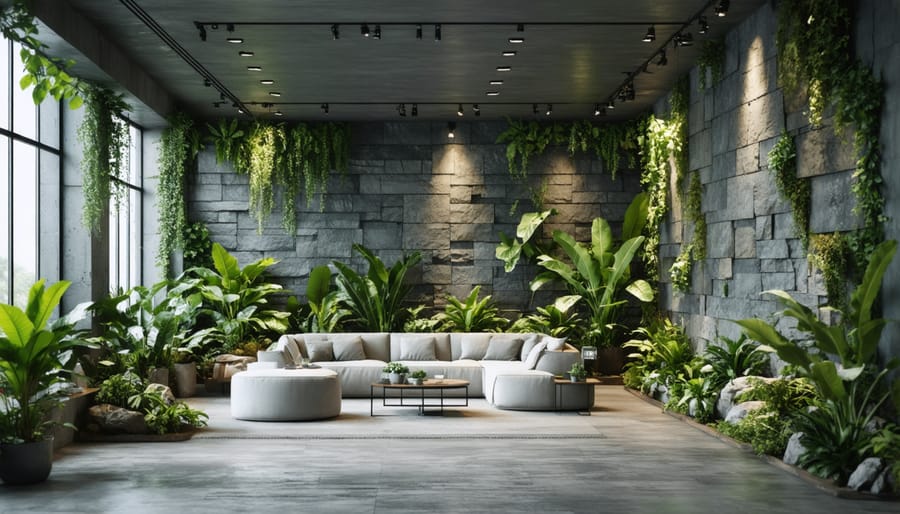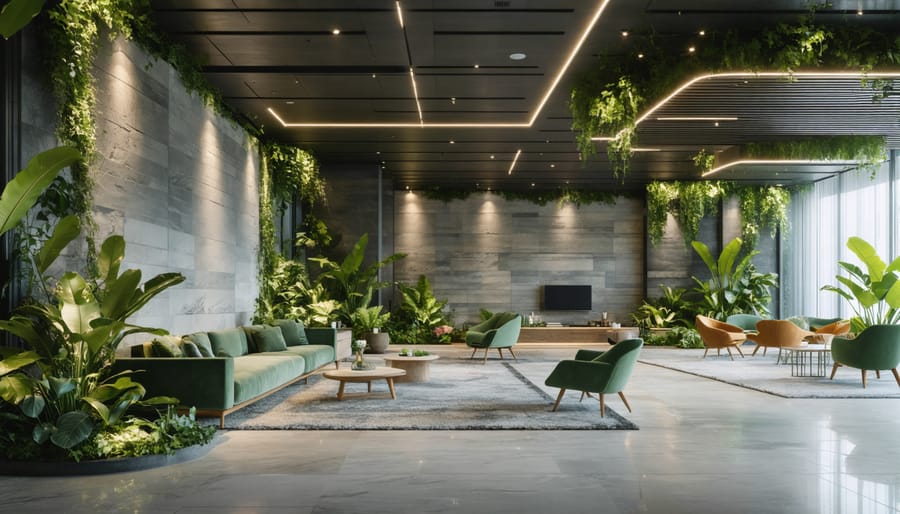In the evolving landscape of commercial architecture, natural stone in commercial design stands as a testament to enduring elegance and sustainable building practices. Stone commercial properties command 23% higher rental rates and maintain their value 40% longer than traditional building materials, making them a premier choice for long-term investment. From the timeless appeal of granite-clad office buildings to the sophisticated charm of limestone retail facades, natural stone transforms commercial spaces into landmarks that appreciate in both value and prestige.
Modern engineering advances have revolutionized stone installation methods, reducing construction timelines by up to 30% while enhancing structural integrity. These innovations, combined with stone’s inherent durability and minimal maintenance requirements, deliver exceptional lifetime value for commercial property investors. Whether adapting historic buildings or creating contemporary commercial spaces, stone’s versatility provides unlimited design possibilities while ensuring sustainable, energy-efficient operations for decades to come.
Why Natural Stone Elevates Health-Conscious Commercial Spaces
Non-Toxic and Chemical-Free Properties
Natural stone stands out as one of the most environmentally conscious and health-friendly building materials available for commercial properties. Unlike manufactured materials, stone contains no artificial additives, volatile organic compounds (VOCs), or synthetic chemicals that could potentially off-gas into indoor environments. This inherent purity makes it an ideal choice for creating healthy indoor spaces that promote occupant wellbeing.
The chemical-free nature of stone contributes significantly to superior indoor air quality, making it particularly valuable in enclosed commercial environments where air quality is crucial. Unlike many modern building materials, stone doesn’t release harmful substances over time, nor does it harbor allergens or support the growth of mold and bacteria.
Additionally, stone’s natural composition means it doesn’t require harsh chemicals for maintenance. Simple cleaning with mild, eco-friendly solutions is typically sufficient to maintain its appearance and hygiene. This characteristic not only benefits the environment but also reduces exposure to cleaning chemicals for maintenance staff and building occupants.
For commercial properties aiming to achieve green building certifications or wellness-focused design standards, stone’s non-toxic properties align perfectly with these objectives while providing lasting durability and timeless appeal.
Antimicrobial Advantages
Natural stone surfaces offer remarkable antimicrobial properties that make them increasingly valuable in commercial spaces where hygiene is paramount. Certain stones, particularly granite and quartzite, naturally resist bacterial growth and pathogen colonization due to their dense crystalline structure and low porosity. These inherent characteristics create an inhospitable environment for microorganisms, reducing their ability to multiply and spread.
Laboratory studies have shown that bacteria survival rates are significantly lower on natural stone surfaces compared to many synthetic materials. For example, granite’s natural composition includes trace minerals that can inhibit microbial growth, while its smooth, sealed surface prevents bacteria from finding places to harbor and reproduce.
In healthcare facilities, restaurants, and other high-traffic commercial environments, this natural resistance to pathogens provides an additional layer of protection alongside regular cleaning protocols. While no surface is completely antimicrobial, natural stone’s properties contribute to a more hygienic environment without the need for chemical treatments or artificial antimicrobial additives.
When properly sealed and maintained, these antimicrobial advantages remain effective throughout the stone’s lifetime, making it a sustainable choice for health-conscious commercial spaces.

Best Stone Varieties for Health-Centric Commercial Applications
Quartzite for High-Traffic Areas
Quartzite stands out as a premier choice for high-traffic commercial spaces, combining exceptional durability with striking aesthetic appeal. This metamorphic stone’s natural composition of compressed sandstone results in a material that’s harder than granite, making it ideal for demanding commercial environments. Its resistance to scratching, etching, and heavy foot traffic makes it particularly valuable in retail spaces, hotel lobbies, and corporate headquarters.
Beyond its impressive durability, quartzite offers versatility in design applications. Available in a range of colors from pure whites to dramatic greys and warm earth tones, it can be customized with various stone finishes to achieve different visual effects while maintaining its inherent strength.
Commercial property owners appreciate quartzite’s low maintenance requirements and excellent return on investment. Unlike softer stones, it doesn’t require frequent sealing and can withstand heavy cleaning protocols common in commercial settings. Its natural resistance to UV radiation also makes it suitable for both indoor and outdoor applications, from grand entrance ways to exterior cladding.
The stone’s crystalline structure reflects light beautifully, contributing to brighter, more welcoming spaces. This characteristic, combined with its natural variation in patterns, allows designers to create distinctive commercial environments that maintain their appeal even under intense daily use. For properties seeking both practicality and sophistication, quartzite delivers an optimal balance of performance and visual impact.

Limestone for Therapeutic Spaces
Limestone’s natural warmth and organic textures make it an ideal choice for creating therapeutic environments in commercial spaces. Its soft, neutral tones and gentle patterns have been proven to reduce stress and promote a sense of calm, making it particularly valuable in healthcare facilities, wellness centers, and spa environments.
The versatility of limestone allows designers to incorporate wellness-focused elements throughout a space. From limestone accent walls that serve as meditation focal points to smooth flooring that encourages mindful walking, each application can contribute to the overall therapeutic atmosphere.
Research has shown that natural materials like limestone can help lower blood pressure and reduce anxiety levels in commercial environments. The stone’s ability to maintain consistent indoor temperatures also contributes to physical comfort, while its natural variations in color and texture create visual interest without overwhelming the senses.
When designing therapeutic spaces, consider incorporating limestone in:
– Reception areas to create welcoming, stress-reducing entrances
– Treatment rooms for a grounding, earth-connected atmosphere
– Meditation spaces where the stone’s natural beauty supports contemplation
– Water features that combine limestone’s texture with soothing sounds
– Recovery areas where the material’s cooling properties promote healing
The key to successful implementation lies in selecting the right finish and pattern to complement the specific healing purpose of each space.
Design Strategies for Wellness-Focused Stone Integration
Biophilic Design Elements
Natural stone elements serve as the cornerstone of biophilic design, creating powerful connections between indoor commercial spaces and the natural world. This integration goes beyond mere aesthetics, tapping into humans’ innate affinity for nature to enhance occupant wellbeing and productivity.
Stone’s versatility allows for various implementations that support biophilic principles. Exposed stone walls create tactile experiences and visual interest, while stone flooring establishes grounding elements that mirror natural landscapes. When combined with professional lighting techniques, these features can dramatically enhance the natural characteristics of the stone, creating dynamic shadows and highlighting unique patterns.
Key biophilic applications include:
– Water features incorporating natural stone
– Mixed-material designs combining stone with living walls
– Stone pathways that guide movement through spaces
– Textured stone surfaces that engage multiple senses
– Natural stone patterns that echo organic forms
Studies show that incorporating these elements can reduce stress levels by up to 15% and increase productivity by 8% in commercial environments. The careful selection of stone colors and textures can also influence cognitive performance and emotional wellbeing, with earth tones and natural patterns proving particularly effective at promoting calm and focus in workplace settings.
To maximize these benefits, designers should consider stone’s natural variations and implement them in ways that reflect local geology and cultural connections, creating authentic and meaningful spaces that truly resonate with occupants.

Acoustic and Thermal Benefits
Natural stone offers exceptional acoustic and thermal performance benefits in commercial properties, serving as both a functional and aesthetic building material. The dense composition of stone naturally absorbs and diffuses sound waves, helping to reduce noise pollution and create more comfortable interior environments. This is particularly beneficial in high-traffic areas like lobbies, conference rooms, and open-office spaces where sound management is crucial.
Different stone varieties offer varying degrees of sound absorption. For instance, porous stones like limestone and travertine provide superior acoustic dampening properties compared to denser materials like granite. When properly implemented in wall cladding or flooring systems, stone can significantly reduce echo and reverberation times.
Thermally, stone’s high thermal mass makes it an excellent material for temperature regulation. It absorbs heat during warm periods and releases it slowly when temperatures drop, contributing to more stable indoor temperatures throughout the day. This natural thermal regulation can lead to reduced heating and cooling costs while maintaining consistent comfort levels for occupants.
In modern commercial buildings, stone’s thermal properties can be enhanced through strategic placement and integration with other building systems. For example, stone flooring in areas with direct sunlight can help regulate temperature fluctuations, while stone wall cladding can provide additional insulation benefits. This passive temperature control not only improves energy efficiency but also creates a more sustainable building environment.
Natural stone stands as a cornerstone of health-conscious commercial design, offering a perfect blend of aesthetic appeal and wellness benefits. The implementation of stone elements in commercial spaces has proven to enhance both physical and psychological well-being while providing sustainable, long-lasting solutions for modern building needs.
The versatility of natural stone makes it an ideal choice for various commercial applications, from healthcare facilities to corporate offices. Its inherent properties contribute to improved indoor air quality, reduced maintenance requirements, and superior acoustic performance. The material’s durability ensures a lasting investment that appreciates over time, while its timeless appeal creates spaces that remain relevant and engaging for years to come.
By incorporating natural stone into commercial properties, businesses demonstrate their commitment to occupant health while creating environments that promote productivity and well-being. The material’s thermal properties help regulate indoor temperatures naturally, contributing to energy efficiency and sustainable building practices.
As we look toward the future of commercial design, natural stone continues to evolve as a premier choice for health-conscious spaces. Whether used in flooring, wall cladding, or architectural features, stone provides an unmatched combination of functionality and beauty. For property owners and designers seeking to create spaces that prioritize wellness while maintaining professional aesthetics, natural stone offers a compelling solution that stands the test of time.
Consider integrating natural stone into your next commercial project to create spaces that not only look exceptional but actively contribute to the health and well-being of occupants.










